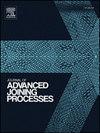Optimizing microstructure and performance: The impact of pre-deformation and rotational speed on friction stir processed Cu-W composites
IF 4
Q2 MATERIALS SCIENCE, MULTIDISCIPLINARY
引用次数: 0
Abstract
This study investigated the effects of pre-deformation induced by asymmetric rolling on copper-based metal, as well as rotational speed during friction stir processing, on the microstructure, mechanical properties, and electrical conductivity of tungsten-reinforced copper matrix composites. The results show that increasing the rotational speed up to 800 rpm leads to a more uniform distribution of tungsten particles within the stir zone. However, at rotational speeds above 800 rpm, the distribution of tungsten reinforcing particles becomes less uniform. The accumulated strain in the stir zone increases from 0.3056 to 0.3967 s-1 as the rotational speed rises from 600 to 1200 rpm. Additionally, as the tool rotational speed increases from 600 to 1200 rpm, the grain size in the stir zone grows from 6.2 ± 0.7 to 13.2 ± 1.5 µm. The Cu-W composite processed at a tool rotational speed of 800 rpm achieves the highest values in hardness (124.9 ± 8.9 HV0.1), ultimate tensile strength (307.4 ± 11.8 MPa), tensile toughness (92.1 ± 1.1 MJ/m3), and electrical conductivity (92.8 ± 1.3 %IACS). Compared to the as-rolled copper-based metal, the electrical conductivity of the Cu-W composite fabricated at 800 rpm increases by 8.8 %.
优化组织和性能:预变形和转速对搅拌摩擦加工Cu-W复合材料的影响
研究了不对称轧制对铜基金属的预变形以及搅拌摩擦过程中的转速对钨增强铜基复合材料显微组织、力学性能和电导率的影响。结果表明,当转速提高到800 rpm时,搅拌区内钨颗粒的分布更加均匀。然而,当转速超过800转/分时,增强钨颗粒的分布变得不均匀。当转速从600转/分增加到1200转/分时,搅拌区累积应变从0.3056 s-1增加到0.3967 s-1。此外,当刀具转速从600转/分增加到1200转/分时,搅拌区的晶粒尺寸从6.2±0.7µm增加到13.2±1.5µm。当刀具转速为800 rpm时,Cu-W复合材料的硬度(124.9±8.9 HV0.1)、抗拉强度(307.4±11.8 MPa)、抗拉韧性(92.1±1.1 MJ/m3)和电导率(92.8±1.3% IACS)均达到最高值。与轧制时的铜基金属相比,在800转/分下制备的Cu-W复合材料的电导率提高了8.8%。
本文章由计算机程序翻译,如有差异,请以英文原文为准。
求助全文
约1分钟内获得全文
求助全文

 求助内容:
求助内容: 应助结果提醒方式:
应助结果提醒方式:


